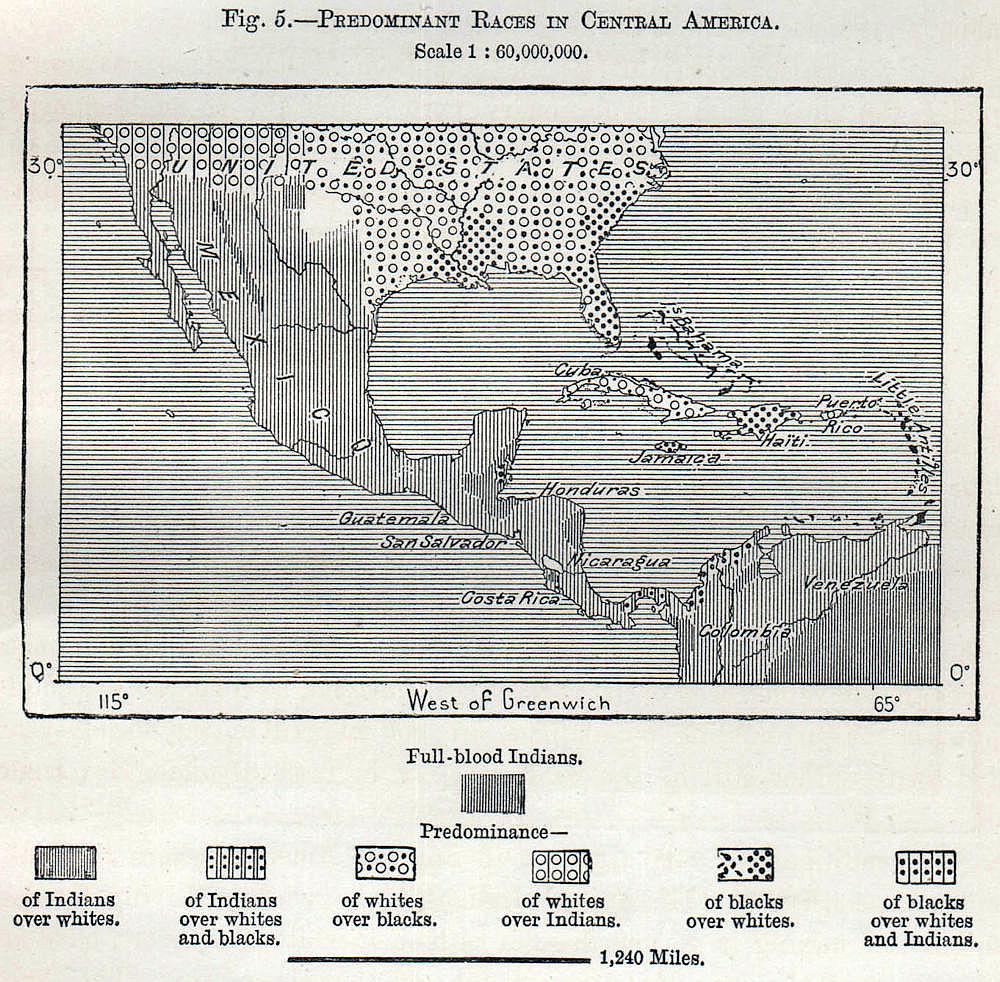Predominant Races in Central America Map


David Chen
Data Visualization Specialist
David Chen is an expert in transforming complex geographic datasets into compelling visual narratives. He combines his background in computer science ...
Geographic Analysis
What This Map Shows
The 1885 map illustrating the predominant races in Central America provides a captivating snapshot of the region's demographic composition during a pivotal moment in its history. This historical visualization categorizes populations based on their racial and ethnic backgrounds, highlighting the intricate mosaic of cultures that have shaped Central America. At a glance, one can see the distribution of indigenous peoples, Europeans, and African descendants, revealing the complex interplay of migration, colonization, and social dynamics that have influenced this area.
Deep Dive into Racial Composition in Central America
Central America has a rich tapestry of racial and ethnic identities, and understanding these distinctions is crucial for grasping the region's historical and cultural evolution. The predominant races depicted in the 1885 map include indigenous groups, mestizos (those of mixed indigenous and European descent), and people of European and African ancestry.
Historically, the indigenous populations were the original inhabitants of the region, having established advanced societies long before European contact. Major groups included the Maya, who thrived in present-day Guatemala and Belize, and the Lenca and Nahua peoples in Honduras and El Salvador. However, with the arrival of Spanish colonizers in the 16th century, the demographics began to shift drastically. The Spanish established colonial rule, which led to significant intermarriage between Europeans and indigenous peoples, giving rise to the mestizo population that became predominant in many areas.
Interestingly, by the late 19th century, mestizos represented a substantial portion of the population, particularly in countries like El Salvador and Nicaragua. This blend of cultures created a unique identity that combined indigenous traditions with European influences, evident in language, religion, and customs. For instance, the Spanish language predominates across the region, but many indigenous languages still survive, showcasing the resilience of these communities.
On the other hand, the African influence, primarily resulting from the transatlantic slave trade, is most prominently seen in the Caribbean coast of Central America. Countries like Belize and parts of Honduras have significant Garifuna populations, descendants of Carib, Arawak, and West African ancestry. The cultural contributions of Afro-Caribbean communities are evident in music, dance, and culinary traditions, enriching the region's cultural landscape.
The demographics in this map highlight patterns of settlement and social hierarchy that continue to influence Central America today. As we delve deeper, it becomes clear that these racial compositions were not merely a product of historical events but also shaped the socio-economic structures and political landscapes of the nations.
Regional Analysis
Examining the map by region offers a clearer picture of the racial dynamics at play. For instance, in Guatemala, the indigenous population remains one of the highest in the region. With over 40% of the population identifying as indigenous today, the legacy of the Maya civilization is strong. The map from 1885 reflects this with a significant representation of indigenous peoples, particularly in the highlands.
In contrast, El Salvador is predominantly mestizo, with estimates suggesting around 90% of the population falls into this category. The historical context of land ownership and political power has led to a significant mestizo identity, shaped by centuries of Spanish colonization and subsequent social policies.
Nicaragua presents a mixed scenario; the Pacific Coast is largely mestizo, while the Caribbean coast is home to ethnic groups like the Miskito and other indigenous peoples, alongside Afro-descendants. This division highlights the varying degrees of cultural influence and the distinct historical experiences of these populations.
Honduras reflects similar complexities, with a growing mestizo population and significant indigenous communities, yet the historical context of colonization has led to different social dynamics compared to its neighbors.
Significance and Impact
Understanding the racial composition of Central America in 1885 is more than an academic exercise; it is essential for recognizing how historical injustices and social hierarchies have shaped modern-day challenges. The legacies of colonialism, racism, and socio-economic disparity continue to influence the region, resulting in ongoing struggles for indigenous rights, land ownership, and cultural preservation.
Current trends show a resurgence of indigenous identities and movements aimed at reclaiming cultural heritage and rights. The map serves as a reminder of the historical context that has fueled these movements, emphasizing the importance of acknowledging diverse racial backgrounds in discussions about national identity and unity.
As we look to the future, understanding these demographic patterns will be crucial for addressing social inequalities and fostering a more inclusive society in Central America. The interplay of race and culture remains a dynamic and evolving aspect of the region's identity, one that will continue to shape its trajectory in the years to come.
Visualization Details
- Published
- October 22, 2025
- Views
- 38
Comments
Loading comments...